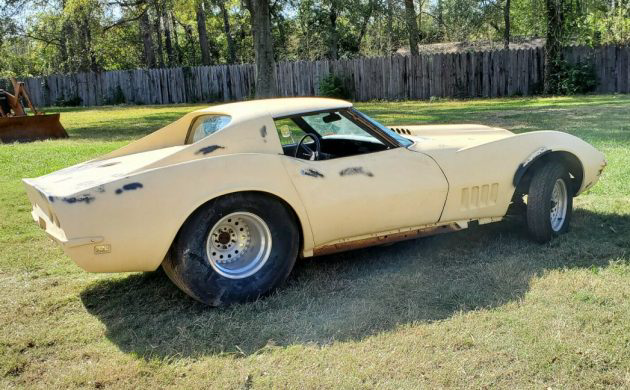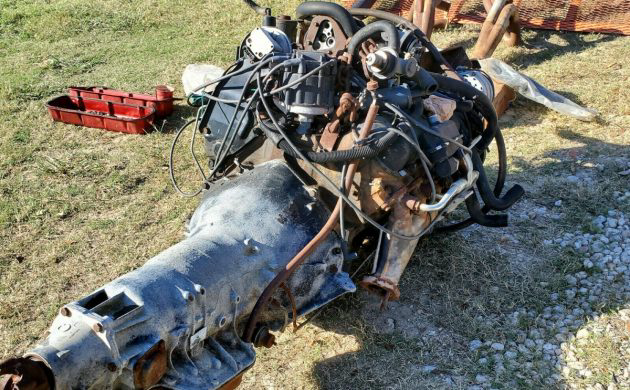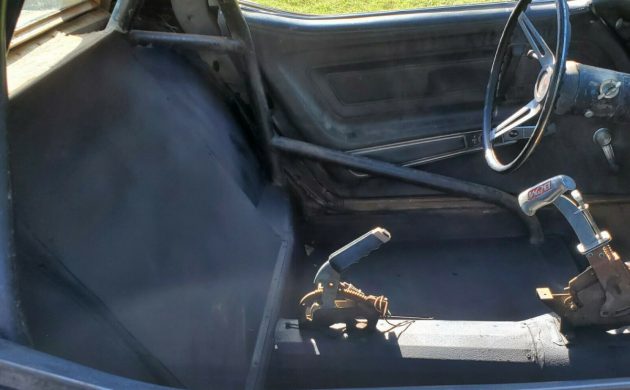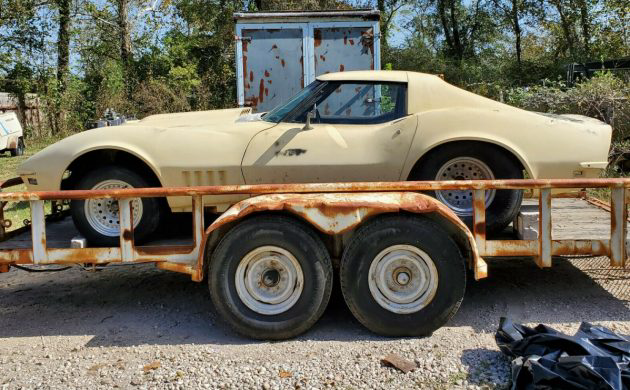Drag Race Prepped:1969 Chevrolet Big-Block Corvette
It was not unusual in the ’60s and ’70s to find a C2 or C3 Corvette set up for drag racing. I have to admit, I really never understood why. Wasn’t the ‘Vette supposed to be the refined road car? A handler? Shouldn’t drag racing be the province of the Camaro or Nova? Sure the ‘Vette had oomph and could power forward in a straight line but was that really its primary purpose? Whatever the answers, here’s a chance to examine a 1969 Corvette that has undergone a dragster repurposing. It is located in Houston, Texas and is available, here on eBay for a current bid of $3,600, reserve not yet met.
One look at this Corvette and its hugely oversized rear tires tells you something’s up. And the Ford nine-inch live rear axle is another affirmation. The stripped exterior visual pretty well drives it all home. Surprisingly, the seller states nothing about this Chevy’s past, how it ended up as it is, whether it ever really did race, what class, etc. What’s obvious is the exterior trim and bumpers are missing, the rear valance is not all there, and there is a pile of parts included with the sale, the right parts? Who knows. (I hope the seller doesn’t store this stuff outside, scattered about.)
Now there is a detached big-block engine that is included but which big-block? Don’t know. It doesn’t look like a race-prepared engine, especially with the A.I.R. pump lines attached to the cast iron manifolds. It looks like a much later smog version rat, perhaps a 454 from a truck or a Caprice. Chevrolet offered four different varieties of the big-block engine in ’69, all 427 CI varieties, with HP ratings of 390, 400, 435, and the, off-road only L88 (116 total) rated at a conservative 430. It’s probably not likely that this engine is one of those. Determination will require more sleuthing. There is a Turbo-Hydramatic 400, three-speed automatic transmission attached to the unidentified motor but its operational status, like that of the motor, is unknown.
The interior has gone full-race on us with sheet metal modifications and a roll cage. The dash and instrument panel are still in place, as is a B&M race shifter with line-lock, but whether any of it usable or not is another item for the growing list of questions. The parts pile does not include anything that resembles seats.
It would seem to be apparent that this is a one-way ‘Vette, it’s set up for quarter-miling and it’s probably never going to return to being just a nice, streetable Corvette. So if that is one’s thought, it would be best to look elsewhere. But if building a quarter-mile machine of the Chevrolet persuasion is the goal, this example may be just the ticket. And if it is, a lot of the serious race-prep stuff has already been done. That just leaves one question, why a Corvette?
Auctions Ending Soon
 2002 Subaru Impreza WRXBid Now2 days$333
2002 Subaru Impreza WRXBid Now2 days$333
 1975 Chevrolet Corvette ConvertibleBid Now2 days$4,000
1975 Chevrolet Corvette ConvertibleBid Now2 days$4,000
 1964 Ford F-100 Camper CustomBid Now2 days$2,000
1964 Ford F-100 Camper CustomBid Now2 days$2,000
 2006 Jeep Wrangler SportBid Now4 days$10,500
2006 Jeep Wrangler SportBid Now4 days$10,500
 1974 Datsun 260ZBid Now6 days$200
1974 Datsun 260ZBid Now6 days$200






Comments
I think this is sacrilegious . But It’s better than leaving it to the elements I suppose . Up next : A Rolls Royce with Cragars on it .
why not a vette?
I don’t understand why not more vettes, a 2 seater makes more sense for a task that only needs one.
I agree. I think the reason you didn’t see more at the strip was due to the higher cost of the donor vehicle.
Back in the early 70s there was a 1st gen (53-54) Vette, that had been turned into a gasser, that ran at the local 1/8 mile. No fancy paint, just red primer. Looked close one day and it looked like someone had taken 36 grit and removed the paint? Probably the reason for the primer…. I wonder if the person that had it ever kinks himself in the ass for doing that to a first gen Vette.
The guy is probably dead now, suffering in hell for doing that.
Hell came looking for him… Looks so bad
Lightweight, two seat, horsepowerful terror makes the Corvette a choice, especially these 427 powered Vettes. Going quickly in a straight line is just another form of racing, plenty of Vettes were in on it. I dont believe this one here was ever completed as a racer or possibly, although doubtful, as some form of street freak/early pro street project. Cars like this make you wonder about the intended result.
Oh my, it looked like there were good intentions building this into a gasser. Stopping midstream leaves question to how much it would it cost to complete the work. The end game most likely be occasional trips to the local track. Or possibly having a Sunday “bump & thump” around town cruiser for car hop appearances.
Absolute junk! Period.
Pro built frame & chassis. Bog Block power & lots of spare parts.
I myself am both a Vette lover, and a fan of Drag Racing.The early years in NHRA dragracing… many top name drivers in the pro classes(Pro Mod, AA/FC,and NitroFC, chose Vette for their low profile sleek body shapes,and ofcourse for their overall light weight ,etc. Infact my good friend ,and 17x Nitro FC ChampionJohn Force started his career driving a Early 70’s body style CORVETTE (FIBERGLASS Reproduction of). For several years ,as did many of his fellow competitors. Some of whome still run a Side ” Nostalgia FC” class with vette bodied cars to this day .Promod classes still run the 60’s styled bodysuits on drag built chassis they all made corvettes popular in the sport, and with the fans of,buying stemreet cars like what they ran on track.
Theres no sacralgious intent to any of it,then or now, they just make great race cars .
If it is a true Big Block….a lot of elbow grease and $$$. , could bring this lost sheep back in the fold.
First gen Corvettes we’re more popular in drag racing due to the solid rear axle
The independent rear was harder to hook up and easier to break so not as common in drag racing, although there we’re some succesfull gen 2 and later vettes drag racing. Not sure on weight but it was easier and cheaper to take a big block and put it in a chevy II or Camaro than a vette ( or small block, you all know what I mean)
I call B.S. on ‘off-road only L88’!! I sold one brand new in December 1968 for $9,650 Canadian. And it was licensed and driven on the street. It resold a few years ago for over $400,000 at auction. I was able to provide the original bill of sale which I still have!!
That was Chevrolet’s “warning” in the sales brochure, not my admonition.
JO
The Canadian brochures made no mention of the L-88 option. I learned about it from Vince Piggins of Chevrolet High Performance ( who also gave me the order codes for the COPO Camaros and Chevelles)!
The U.S. brochure did and the page is attached.
JO
Big Block power & Pro-built Frame & Chassis Has most parts to make it a complete race car. Probably too much needed to revert back to a stock BBC vette.
Complete the build to street spec and have fun at your local cars and coffee…
Tons of Corvettes on the drag strips in the 60s and 70s. As for handling, the early cars did not handle well and it took modifications to get them around corners fast… and safely. After market folks and even the factory had the parts to accomplish that. Like JagManBill’s idea. It would certainly get folk’s attention.
Looking at the offering again, there are 3 pedals so it would be fun to see a VIN breakdown to know what your playing with. Wouldn’t it be crazy if this was a 427 430hp 4 speed car? NOW what do you do with it?!?!
This is a 1969 model year. The VIN won’t reveal that info. You would need the tank sticker or a manifest (build sheet).
Here’s the VIN: 194379S717426 all it tells you is:
1: Chevrolet
9: Corvette
4: V8
37: Coupe
9: 1969 model
S: St. Louis assembly
717426: Sequence number
GM’s VIN’s weren’t that informative in the ’60s.
JO
yeah… I thought about it and pulled the VIN myself after I posted it. But since you can’t edit anymore I just left it alone. I’ll bet the build sheet and sticker are long gone at this point